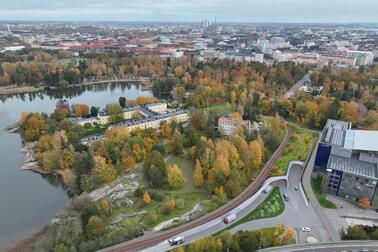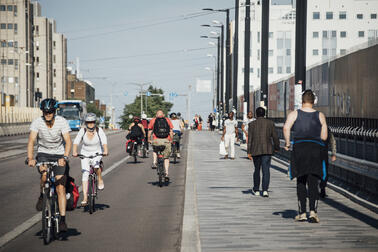
The mapping project was carried out in accordance with both the European Union’s Environmental Noise Directive and national regulations. The calculation methods and results for each differ from each other. One of the objectives of the Environmental Noise Directive is to gather comparable information on the noise situation in EU member states. The results of the national noise mapping project are used, for example, as initial data for noise abatement and land use planning in the city.
Road and street traffic is the most significant source of noise in Helsinki
Calculated according to the Environmental Noise Directive, the number of Helsinki residents exposed to day–evening–night noise levels (Lden) above 55 dB from road traffic is approximately 236,000, or 36% of the city’s population. Approximately 6% of the city residents are exposed to tramway noise. Approximately 1.5% of the residents are exposed to railway traffic noise and just under one per cent to metro noise. Due to changes in the calculation model and the calculation method for residents exposed to noise, the results cannot be compared to the results of previous EU noise mapping projects.
The results of the national calculation are comparable to those of the corresponding mapping project five years ago. According to this, the number of people exposed to daytime noise from road traffic (LAeq,7–22) is approximately 256,500, representing 39% of the population of Helsinki. In relation to the city’s population, the increase compared to the previous noise mapping project is two percentage points. The increase in the number of people exposed is explained by the increase in the number of residents in noise areas in the vicinity of traffic routes and the inclusion of new streets in the project.
According to the national calculation method, around 6% of city residents are exposed to daytime tramway noise above 55 dB, 1% to railway noise, and 1.4% to metro noise.
The noise mapping project examines outdoor noise levels.
The noise mapping gives an idea of how many city residents live in environments that are burdened by noise. Calculations of the number of people exposed do not take into account noise abatement in residential buildings, so they do not reflect the number of people exposed to traffic noise indoors. In new residential buildings, noise abatement is required so that the noise levels are below the guideline values inside buildings and in playgrounds and recreational areas.
On the basis of the noise mapping project results, preparation of the next noise abatement action plan to improve the city’s soundscape will begin in the near future. The plan will be completed in summer 2024.
The noise mapping project was carried out in cooperation with the cities of Espoo, Vantaa and Kauniainen and the Finnish Transport Infrastructure Agency, and it was prepared by Promethor Oy.
Link to the EU report (pdf, Summary in English)
Link to the national report (In Finnish)


